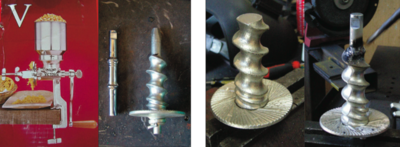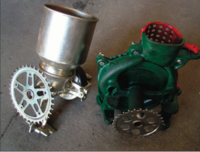Difference between revisions of "Pedal-Powered Food/Grain/Coffee Mill"
| Line 32: | Line 32: | ||
'''The Flywheel'''<br> | '''The Flywheel'''<br> | ||
| + | [[File: Pedal_mill_7.png|400px|Pedal mill]]<br> | ||
| + | [[File: Pedal_mill_8.png|400px|Pedal mill]]<br> | ||
| + | [[File: Pedal_mill_9.png|400px|Pedal mill]]<br> | ||
'''The Seat'''<br> | '''The Seat'''<br> | ||
| + | [[File: Pedal_mill_10.png|400px|Pedal mill]]<br> | ||
'''The Handlebars'''<br> | '''The Handlebars'''<br> | ||
| + | [[File: Pedal_mill_11.png|400px|Pedal mill]]<br> | ||
We use steel dropped racer bars. Cut them in half. In order to bolt on the hangle bars, we weld 8mm bolts onto 20mm washers. | We use steel dropped racer bars. Cut them in half. In order to bolt on the hangle bars, we weld 8mm bolts onto 20mm washers. | ||
'''The Chain Assembles'''<br> | '''The Chain Assembles'''<br> | ||
| + | [[File: Pedal_mill_12.png|400px|Pedal mill]]<br> | ||
| + | [[File: Pedal_mill_13.png|400px|Pedal mill]]<br> | ||
These are then welded onto to cut ends of the handlebar and filed smooth. They are then ready to be bolted onto the chassis. The drive side derailleur is bolted in place as it would be on the bike. However it will need to be filed to fit flush with the frame. We use the old style of derailleur that bolts onto the axel rather than the bike frame. Now you can add a gear shifter. A simple friction type is best than an index shifter. Use the adjust- ment screws on the derailleur to make sure it se- lects all gears without the chain coming off. | These are then welded onto to cut ends of the handlebar and filed smooth. They are then ready to be bolted onto the chassis. The drive side derailleur is bolted in place as it would be on the bike. However it will need to be filed to fit flush with the frame. We use the old style of derailleur that bolts onto the axel rather than the bike frame. Now you can add a gear shifter. A simple friction type is best than an index shifter. Use the adjust- ment screws on the derailleur to make sure it se- lects all gears without the chain coming off. | ||
Revision as of 21:07, 27 February 2010
Contents
Short Description
- Problem: Lack of electricity or lack of an electrical grinder.
- Idea: Combine a bicycle and a hand mill to a pedal-powered mill.
- Difficulty:
- Price Range:
- Material Needed: Bicycle, metal bars, wood, hand-operated mill, welding device
- How Many people?
- How Long does it take?
Concept
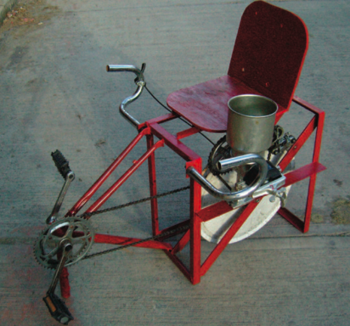
The machine is easy to operate, easy to maintain and reasonably portable. It can be used anywhere by virtually anyone. It is also a simple matter to switch from degraining to milling by unbolting one appliance and attaching the other.The Mill function has the capacity to mill 3 lbs. per minute of any type of grain or coffee beans. The most common use is for milling yellow maize, soya beans, and other elements that make up animal feed. The Corn Degrainer for example is used postharvest and easily degrains 1200 to 1500 lbs per day.
How to Build the Mill
The Chassis
[[]]
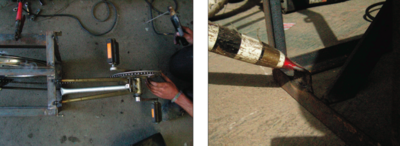
The bike frame is cut as above. The frame shown in the pictures has a 450mm eat tube, 250mm down tube. The full length of chain stays.
Form the 90 degree corners as shown, cutting, folding and welding the angle iron. Weld the bike frame in place, lining up the sprockets so the chain will run straight. You will need to bend the drive-side chain stay in order to clear the chain. To form a better bond, the frame is flattened and bent before welding it to the chassis. File any sharp edges and paint.
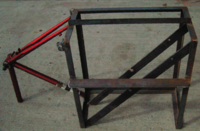
The Flywheel

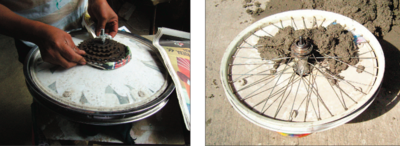
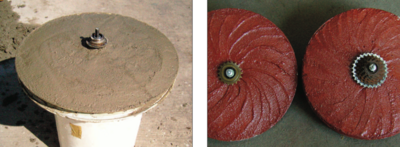
-- dundant unthreaded piece, and tap on a threaded one from an identical hub. Fit spokes using a screwdriver, rather than a spoke ten- sioner for speed. The concrete is painted to protect from moisture. One side accepts a multi speed cassette, the other a single speed sprocket. The axel position will need to be adjusted accordingly.
The Seat
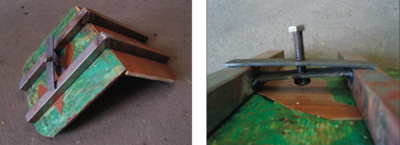
The seat is recycled plywood. The support is made from thin box section steel. See construc-- per to prevent leakage. Mix the cement with two parts sand. Place the wheels on a bucket to provide support. Once filled and smoothed over, place in the shade to dry overnight.
The Handlebars
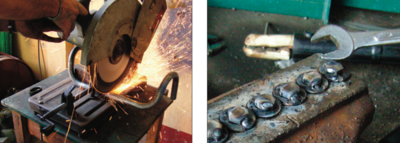
We use steel dropped racer bars. Cut them in half. In order to bolt on the hangle bars, we weld 8mm bolts onto 20mm washers.
The Chain Assembles
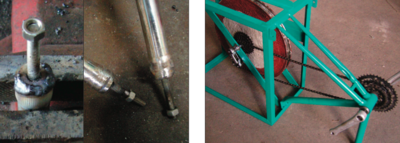
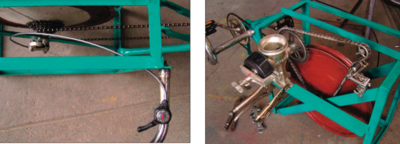
These are then welded onto to cut ends of the handlebar and filed smooth. They are then ready to be bolted onto the chassis. The drive side derailleur is bolted in place as it would be on the bike. However it will need to be filed to fit flush with the frame. We use the old style of derailleur that bolts onto the axel rather than the bike frame. Now you can add a gear shifter. A simple friction type is best than an index shifter. Use the adjust- ment screws on the derailleur to make sure it se- lects all gears without the chain coming off.
- tion before drilling the frame and bolting. Aim to have the chain run as straight as possible.
Success Story
Guatemala
References and Further Reading
- Carlos Marroquin, Henry Godfrey, Maya Pedal 2010, http://www.mayapedal.org/
Related Articles
- ...
